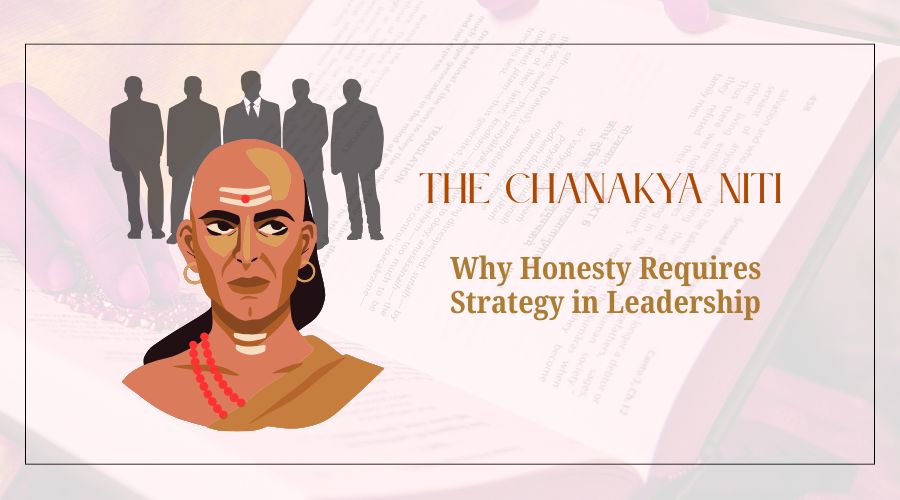
In the field of political philosophy and leadership theory, the teachings of Chanakya (c. 4th century BCE), also known as Kautilya, remain exceptionally relevant. Among his many theories, one motto has drawn consistent scholarly and practical interest. Let's explore this powerful idea in detail below:
Chankya’s most relatable and interesting principle comes from Chanakya Niti 7.12:
“nātyantaṃ saralairbhāvyaṃ gatvā paśya vanasthalīm।
chidyante saralāstatra kubjāstiṣṭhanti pādapāḥ ॥”
Translation - Do not be very upright in your dealings, for you would see by going to the forest that straight trees are cut down while crooked ones are left standing.
This apparent negative statement offers a profound insight into the connection between ethics and getting things done in leadership. Rather than advocating dishonesty, it offers a framework for understanding how ethical intent must support strategic execution.
Chanakya’s political and administrative guides, most notably the ‘Arthashastra’, advocate for statecraft rooted in Dharma (moral duty) but tempered with Anvikshiki (critical thinking). His statement about honesty illustrates a main idea in his philosophy:
Leadership must be principled and practical.
This theory combines mental discipline with honesty, inspiring self-empowerment and guiding nations to pursue stability, prosperity and harmony. Its wisdom is ageless, reminding us that true strength lies in the balance of inquiry, ethics and purposeful action.
Honesty, in the modern ethical framework, is often considered to be a basic good. Chanakya's idea makes us ask:
Is it always best and most ethical to be completely transparent?
From a leadership standpoint, too much honesty, like revealing vulnerabilities prematurely, speaking truths without contextual sensitivity or disregarding power dynamics, can lead to negative outcomes. These may include loss of authority, organisational instability, or strategic disadvantage.
Thus, Chanakya’s Niti points to the principle that honesty must be practised with judgment. Strategic communication, rather than absolute openness, is suggested as the optimal path in high-stakes decision-making.
Historical and contemporary leadership examples reinforce these realistic values. Leaders like Nelson Mandela and Abraham Lincoln have demonstrated the necessity of balancing transparency with calculated discretion to maintain unity, protect long-term interests, and achieve transformational goals.
For instance, Mandela negotiated differently with different leaders. This required smartly hiding internal weaknesses, even while upholding a deeply ethical vision of reconciliation. Similarly, modern corporate leaders such as Satya Nadella have effectively balanced transparency with narrative control to enact cultural shifts within organisations. These cases support the core of Chanakya’s thesis:
Ethical leadership is not merely about moral intent but tactical application.
Chanakya’s Niti aligns with modern concepts such as situational ethics and contextual leadership. These theories argue that strict rules of moral principles and ignoring the situation can be problematic. Instead, ethics must be guided by an awareness of social, political, and psychological realities.
These days, modern leadership training uses helpful tools and techniques such as:
These frameworks are similar to the flexible moral thinking Chanakya proposed over two millennia ago.
The metaphor of the “straight tree” draws attention to visibility as a risk factor. Overly transparent individuals in workspaces, politics and other organisations can be easily used or mistreated.
Leaders who are self-aware, empathetic, emotionally regulated and socially skilled are much better at building strong relationships through communication, whatever their position might be. A leader can be successful by working actively to understand themselves and others.
Integrating Chanakya’s Niti into the leadership curriculum can offer critical lessons. These include:
In this age where everything is changing faster than before, defining dharma based on reality helps leaders to stay practical.
Chanakya believed that “too much honesty” can be dangerous. Leadership in any era, particularly the current one, is difficult to understand & requires balancing moral values with practical action.
The Chanakya Paradox in this theory refers to a smart way of understanding different leadership styles. It suggests that durable success arises not from rigid virtue or ruthless strategy alone, but from their dynamic integration. As such, Chanakya’s insights continue to inform contemporary discussions on ethical governance, organisational leadership, and moral resilience.